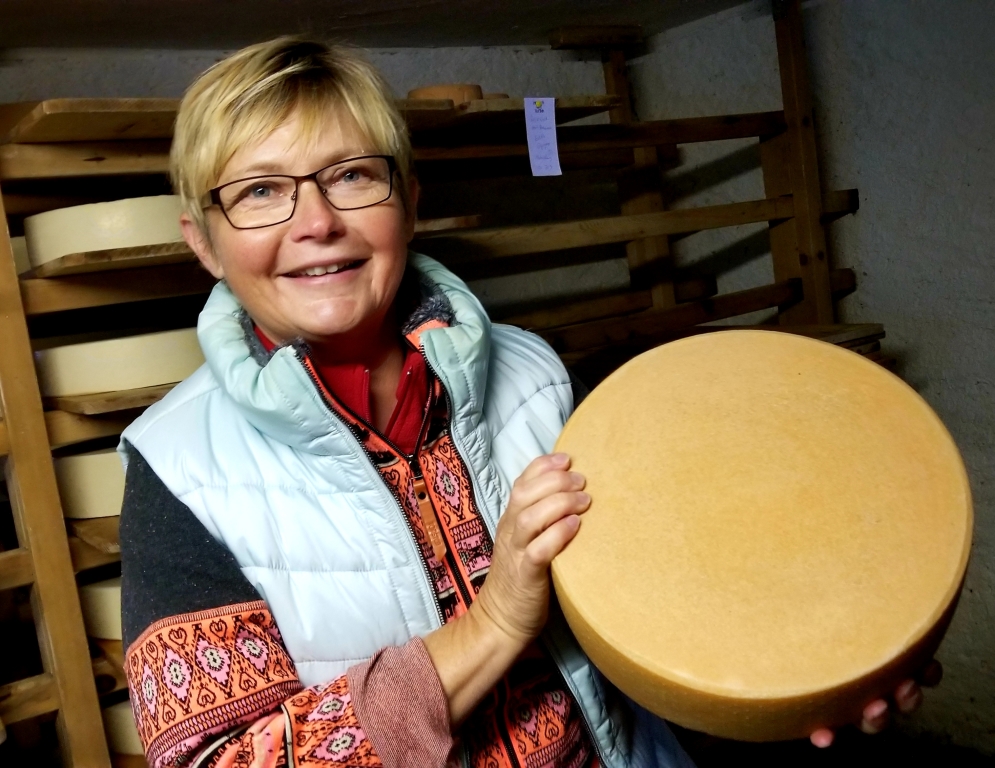There are few things more delightful than hiking through a fragrant pine forest and discovering an ancient alpine dairy nestled in the trees. Even better is when the chatty cheesemaker is there stirring his morning milk in a shiny copper kettle over a crackling wood-burning fire. Clanging cowbells nearby reminds you of the complexity of the cheesemaking process. Making cheese in Switzerland is a spectacle and fascinating process to learn. Come join us as we walk through that process!

Fairy Tale Cheesemaker’s Cottage
This is what I bumped into one morning this summer in the tiny Engadine village of Morteratsch, near Pontresina in southeast Switzerland. The genius behind this fairy-tale setting is Hans Wüthrich, who saw the potential in the centuries-old cheese farm that had fallen into disrepair. Almost three decades ago he decided to bring it back to life using as much of the original structure as possible. The result is Alp-Schaukäserei Morteratsch, a summer-long haven for cheese-lovers in a meadow of wildflowers.

Fresh milk from the family’s alpine cows is brought in and nurtured through the multiple steps that result in the local cheese—Heutaler. After the demonstration in the authentic farm kitchen, onlookers are startled to learn that the cheese must age for 12 months before it is served.
Never Quite Enough Cheese
Each summer, no matter how much they’ve made the year before—they run out. Luckily, last year’s batch was successfully finished and was being served at the luscious and colorful breakfast buffet I bumped into. The cheese-laden feast is held every morning except Monday. And while a bit on the pricey side, does allow you to step into a whole new world.
Spectacular Buffet of Regional Delights
In addition to Heutaler, dozens of other local artisan cheeses, along with hand-crafted air-dried meats, handmade sausages, ripe summer fruits, and freshly baked breads are spread out on huge tables with red and white checkered tablecloths. And if that isn’t enough, you can whip up a personal omelet and stuff it with the some grated Morteratsch Knolle (a dried cheese ball that looks like a large black truffle) to complete your farm breakfast. Be sure to spread some of the homemade jam on the bread—the apple-raspberry is amazing! Making cheese in Switzerland differs from region to region, but nonetheless will also satisfy your taste buds.

Cheese for Sale
Cheese is available for sale at the farm, but if you want to carry some home you may want to visit their cheese shop in Pontresina (near Morteratsch) where they can shrink-wrap your favorite cheese.
The dairy staff is friendly, knowledgeable, and helpful as you sample the vast array of cheeses and meats beautifully displayed. They may even tell you about the cheesemaker you particularly enjoy. Alpine music playing in the background creates an authentic morning of alpine farm life and a day you’ll never forget.
Exploring the Engadine
If hiking to breakfast, tasting a dozen different cheeses, and watching cheesemaker making cheese in Switzerland being made by hand in a 900-year old traditional method sounds fun to you, then check out Alpenwild’s Best of Engadine & St Moritz hiking vacation.

- Making Cheese in the Switzerland - September 19, 2019
- Ticino Breadcake - March 11, 2019
- Delicious Italian Creamy Polenta Recipe - October 7, 2018



Hello. I love Swiss cheeses! I was with my family on vacation in the Gruyere region. We were there for the muselum of cheese. It is a very heavy precaution and time consuming. But thanks to people like you, we can eat such delicious things! Thank you!
The people making the cheese looks so happy. I really bet that they enjoy what they doing as a living. It’s the first time that I come to your blog, I will come back for sure! Thanks for sharing that piece of history, really appreciate. 🙂
Thank you, Nicolas! We are glad you visited our blog. We hope you come back for more great posts, soon!
-The Alpenwild Team